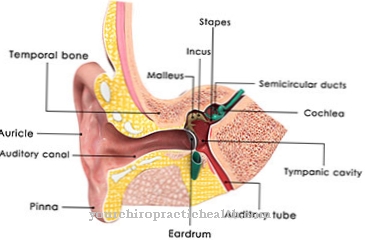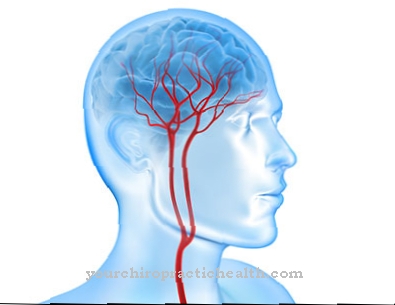Under one masculinization or Androgenization one understands physical-masculine changes in a woman. These occur when there is an excess of male hormones (androgens) in a woman's body.
What is masculinization (androgenization)?
The masculinization occurs in a woman who shows an increased effect of the male hormones, the androgens. In men and boys, these hormones ensure that the primary and secondary sexual characteristics can form and develop.
These include, for example, the testicles, the broken voice and the increased hair on the body from puberty. Androgens also ensure that more muscle mass is built up through protein formation. Women also normally produce low levels of these hormones, but masculinization has an increased level in the blood.
The symptoms are mainly shown in the fact that increased hair growth occurs all over the body and the voice sounds significantly deeper.
causes
There are different causes for it to be one masculinization comes. Usually there is a disorder of the hormone metabolism, which mainly affects the male hormones. For example, the androgens cannot be broken down or converted properly; there is an increase in the level of androgens in the blood.
Another cause of the increased production of male hormones can be a tumor in the adrenal cortex, which is responsible for the production of the hormones, or on the ovaries. The pituitary gland (also called the pituitary gland) controls hormone production by releasing certain hormones. Thus, a tumor on the pituitary gland can ensure that the adrenal cortex or the ovaries produce more androgens, which then also leads to masculinization.
A disturbance of the enzymes and enzyme formation can lead to masculinization; this can be congenital or later in the period up to puberty. A woman who frequently takes hormone preparations, for example anabolic steroids, can derive another cause of masculinization.
Symptoms, ailments & signs
Androgenization of women is mainly shown by physical characteristics. Depending on the intensity, these symptoms can vary and appear to different degrees. There is often a noticeable increase in facial and body hair (hirsutism). In affected women, dark whiskers initially grow on the face, which can increasingly thicken.
A mustache often arises. Typically, no new hair grows on the face, but the existing soft downy hair gradually thickens. In addition, it can lead to increased chest hair.At the same time, the affected women show a pathological, increased hair loss of the scalp hair in typical male hair loss patterns (alopecia).
Usually there is diffuse hair loss in the crown area in the form of a receding hairline. Sometimes there are light spots on the back of the head. The skin's appearance deteriorates significantly due to the influence of male hormones. The sebum glands secrete more sebum. Pimples, abscesses and nodules are therefore more likely to form. Sometimes acne occurs.
Other possible physical symptoms of androgenization are an enlarged clitoris, a visible increase in muscle mass, a deepening voice, increasing regression of the breasts, and disturbances in the menstrual cycle. Infertility can occur in advanced disease. Psychologically androgenization is extremely rare in the form of increased aggression or an increased sex drive.
Diagnosis & course
Is there any suspicion masculinization before, the doctor will carry out a detailed examination and questioning. In order to find the exact cause, some laboratory tests to determine the hormonal balance must be carried out. In this way, the concentration of the various hormones in the body can be determined.
If there is some evidence of a possible tumor in the pituitary gland, ovaries, or adrenal cortex, imaging tests are needed. Above all, computed tomography and ultrasound examinations are carried out in the abdominal cavity, magnetic resonance tomography is used to examine the pituitary gland, as this is more accurate for diagnosing the head.
When should you go to the doctor?
If abnormalities in the hormonal system are noticed in sexually mature girls or women, a check-up visit with a doctor should be initiated. Menstrual disorders, peculiarities of the libido and visual abnormalities should be clarified by a doctor. Heavy hair growth on the face or beard are considered signs of an existing disorder. If a mustache develops, a medical examination should be initiated to clarify the cause. A visit to the doctor is also advisable in the case of hair loss, hairiness in the chest area and discrepancies in the complexion. An increased formation of pimples, abscesses and blemished skin are indications that should be investigated. If there are strong receding hairlines, research into the cause is also recommended.
Special features of behavior, a masculine demeanor or a particularly deep voice should be discussed with a doctor. If psychological problems arise or existing irregularities increase in intensity, the person concerned needs help and support. An unfulfilled desire to have children, an enlarged clitoris and an unusually large amount of muscle mass on the body are also signs of an existing hormonal disorder. In order for a diagnosis to be made, medical tests are required that are used to clarify the cause. If there is no age-appropriate regression and thus a reduction in breast size, the observations should be clarified by a gynecologist.
Treatment & Therapy
The therapy one masculinization is often tedious and can extend over several years. It is important not to interrupt the treatment, otherwise the symptoms may recur. So it takes a strong stamina to achieve a success of the therapy.
In order to begin proper treatment, it is first necessary to know the exact cause of masculinization. In the case of a tumor, for example, surgery and subsequent therapy are essential. If, on the other hand, the cause of masculinization lies in a defect in the enzymes, hormone therapy is initiated in which the production of androgens is suppressed.
The active ingredients are similar to those used in hormonal contraceptives. Depending on how pronounced the masculinization is, it can also be alleviated without hormone therapy, for example if there are signs on the skin. Permanent epilation or laser treatment can reduce excess body hair; the roots of the hair are destroyed and hair growth gradually decreases over time.
prevention
One masculinization can only be prevented if the cause can be found in the use of anabolic steroids. These androgenic preparations should no longer be taken so that masculinization does not progress any further. These are primarily anabolic steroids and doping agents, which ensure that the body builds up muscle mass more quickly.
Aftercare
Masculinization represents a strong emotional burden for the patient. Therefore, the primary aftercare is carried out in the form of psychotherapeutic sessions. The self-esteem of those affected should be stabilized and mental disorders such as depression prevented. The sick often experience bullying or discrimination in their immediate environment.
Psychotherapy can intervene in these cases and prevent the resulting emotional damage. Appropriate handling of the disease is also learned during psychological follow-up care. Follow-up care for androgenization is not limited to the patient alone. Relatives can also suffer from the change and feel overwhelmed.
Then the psychological counseling extends to them too. At the psychotherapeutic facility you have a contact point where you can get professional advice in the stressful situation. In addition to psychotherapeutic approaches, follow-up care for an affected woman also includes consulting a gynecologist.
Androgenization cannot be completely cured; it can only be contained. The specialist will administer hormones that are supposed to regulate the estrogen balance. As part of the follow-up care, the estrogen levels are checked with regular blood samples. If an increased or a lower dose of the hormones is required, the amount will be adjusted accordingly during follow-up care.
You can do that yourself
In the therapy of masculinization, a distinction is made between causal and purely symptomatic treatment. The causal treatment aims to treat an underlying disease. This includes, for example, the discontinuation of so-called anabolic steroids, which athletes often use. If, however, a tumor is the trigger in those affected, the masculinization will slowly regress on its own after successful therapy.
In many cases of those affected, the therapy of masculinization takes a long time, as the actual causes are often not known. In the case of masculinization in which too many androgens are produced in the affected female body, a special hormone therapy can be very promising. However, taking hormone preparations, such as the birth control pill, is only purely symptomatic therapy. Because when you stop taking the hormones, the problems reappear.
Without such hormonal therapy, all of the different symptoms must be treated. In the case of significant acne, special skin care products and cleansing masks made from healing clay can be used. Techniques such as laser hair removal can be used if the patient has increased body hair. The treatment of masculinization is very tedious and should be individually tailored to the symptoms of those affected. Except for not using anabolic steroids, affected women can hardly do anything themselves to treat masculinization.



.jpg)


.jpg)




















